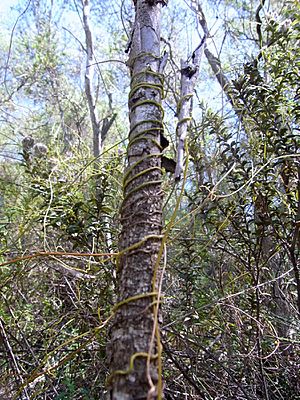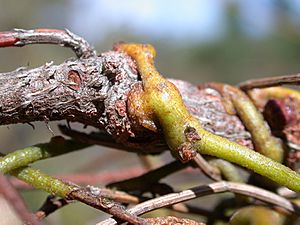Cassytha pubescens facts for kids
Quick facts for kids Cassytha pubescens |
|
|---|---|
 |
|
| Cassytha pubescens on a mallee, Mount Imlay National Park, Australia | |
| Scientific classification | |
| Genus: |
Cassytha
|
| Species: |
pubescens
|
| Synonyms | |
|
|
Cassytha pubescens is a special kind of plant from Australia. It's a vine that gets some of its food from other plants, which means it's a hemiparasitic plant. It belongs to the Laurel family. People call it by many names, like devil's twine, dodder-laurel, or snotty gobble. You can find this plant all over south-eastern Australia.
A Scottish botanist named Robert Brown first officially described this plant in 1810. Its leaves are very tiny, almost like scales. The plant gets its energy from the sun through its green stems, not its leaves. These stems are usually thin, about 0.5mm to 1.5mm wide.

Cassytha pubescens is often compared to another plant called Cuscuta. This is because they look similar and both grow by attaching to other plants.
Contents
What Does Cassytha pubescens Look Like?
Cassytha pubescens grows as a green stem that wraps around itself and around the branches of other plants. Its stems can be between 0.5 and 1.5 millimeters thick. They can look very different depending on where they grow. In dark, wet places, the stems might be dark green and smooth. In other spots, they can be hairy or wrinkly, and their color can even change on the same plant!
The flowers, fruits, and stems of Cassytha pubescens can vary a lot. This might be because different groups of the plant have grown separately. It could also be because the plants change to fit their environment.
Flowers and Fruits
The flowers of Cassytha pubescens can grow in different ways, sometimes on spikes or clusters. They are usually small and close to the stem. The flower stalks can be short or long, and they might have hairs. The flowers have fuzzy petals and nine small parts called stamens.
When the fruit is fresh, it can be green, reddish-green, or grey. It can be smooth or hairy. The fruit is usually round or egg-shaped, about 6-10mm long and 5.5-9mm wide. It might have dull green or reddish-brown stripes. When the fruit dries, it turns grey or black.
The plant usually flowers in the summer, from December to April. The fruits then start to grow from March to April.
Where Does Cassytha pubescens Grow?
Cassytha pubescens is found widely along the east coast of Australia. It does not grow in very dry areas. You can find it from south-east Queensland, through the eastern part of New South Wales, and into south-eastern South Australia. It also grows in eastern and western Victoria and Tasmania. This plant mostly lives in dry forests and woodlands.
How Does Cassytha pubescens Live?
Cassytha pubescens can attach to many different types of plants. It mostly grows on woody shrubs, both native ones and those brought in from other places. This plant spreads mainly by growing new stems. It uses special parts called haustoria to attach itself to the stems of its host plant.
How It Gets Food
The haustoria of Cassytha pubescens are like small disks. They push into the host plant's stem to take water and important nutrients. For the Cassytha pubescens plant to survive, it must attach to a host plant within the first six weeks after it sprouts from a seed.
Helping Control Weeds
Some people think Cassytha pubescens could be used to help control invasive plants. This is because it seems to harm unwanted plants more than native ones. One study looked at how it affected a native plant called Leptospermum myrsinoides and an invasive plant called Cytisus scoparius. The study found that Cassytha pubescens did not hurt the native plant much. However, it significantly reduced the growth and health of the invasive plant.


